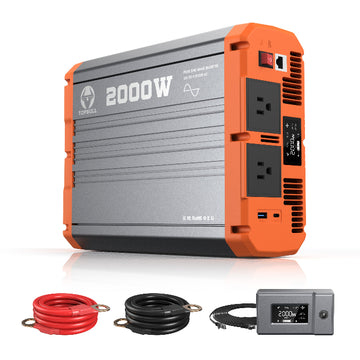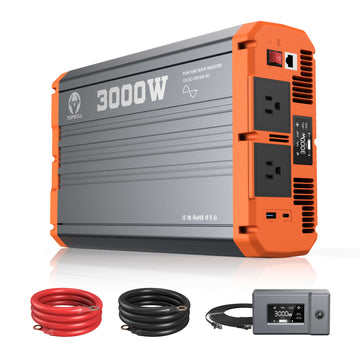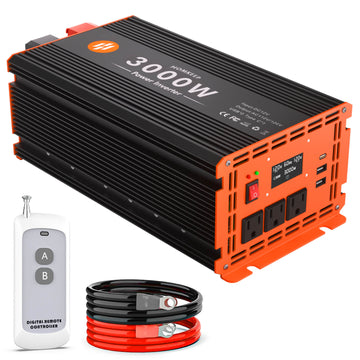As the core component of a photovoltaic system, the inverter undertakes the critical task of converting the direct current (DC) generated by the solar panels into the alternating current (AC) available to the home or business. The selection of its capacity directly affects the system's power generation efficiency, cost control and service life:
-
Insufficient capacity: This can lead to “peak shaving”, where excess power generated by solar panels is wasted because it cannot be converted in a timely manner, and can even lead to the risk of overloading the equipment in severe cases.
- Excess capacity: Although it can ensure the demand for power conversion, the initial investment cost increases significantly, and the efficiency may be lower than 85% at low load operation, resulting in long-term energy waste.
General home users need to choose the capacity of the solar inverter combined with the demand for electricity and solar panel output, usually 1kW to 10kW to meet most of the scenarios, of which 2,000W is suitable for small family basic electricity, 3,000W is suitable for medium-sized families with medium-power equipment, 4,000W and above to meet the needs of large-scale families or multiple devices running at the same time, and it is recommended to set aside capacity redundancy and to consider the future expansion!
According to the U.S. Department of Energy (DOE), a properly matched inverter can increase system power generation by 15-20%. In this article, we will discuss how to choose the right inverter size for your solar system.
Key factors in sizing an inverter
Total power of the solar panels
When selecting an inverter, it is important to first understand the total power of the solar panels you are installing. Each panel has a nominal power (expressed in peak watts (Wp)), which can be calculated based on the number of panels and the power of each panel.
For example, if you have ten 250Wp solar panels, the total power is 2500Wp.
Meeting load requirements: from coffee machines to air conditioning
Next, you need to analyze your home's electricity demand. This includes knowing how much energy is consumed during peak hours (e.g. in the evening or when all the family is at home). You can estimate power consumption by checking your electricity bill or making a list of household appliances to calculate the total power of the load. Make sure that the capacity of the inverter covers the maximum energy demand of your home.
-
Make a list of appliances: distinguish between continuous power (e.g. LED lights) and start-up power (e.g. air conditioning compressor).
- Calculate the peak value: the maximum power of the devices running at the same time.Example: refrigerator (200W) + air conditioner (3kW) + washing machine (500W) = 3.7kW peak
Inverter efficiency
The efficiency of the inverter is also crucial. Most inverters on the market are between 95% and 98% efficient. To calculate the effective output of your inverter, you need to multiply the efficiency of the inverter by the total power of your solar panels. For example, if the total power of your panels is 2500Wp and the efficiency of the inverter is 96%, then the effective output is 2400W.
Future Expansion Requirements
Reserve 20-30% capacity to accommodate future equipment upgrades (e.g., adding heat pumps, charging piles).
Grid-tied or off-grid solar system
Off-grid solar systems are usually larger in inverter size due to independent operation and reliance on battery storage, matching Battery Bank capacity with peak load and integrating complex functions (e.g., battery management); whereas on-grid systems are smaller in inverter capacity due to interconnection with the grid, matching solar panel power and ensuring grid synchronization, with simplified functional design and a relatively low cost.

Three Steps to Precise Calculation
Step 1: Solar System Architecture Diagnosis
Before selecting an inverter, the overall architecture of the PV system needs to be clarified.
Off-grid systems: rely entirely on solar panels and batteries for power supply, so the inverter capacity needs to meet both load demand and battery charge/discharge management. The core components include solar panels, Battery Banks and inverters, and the key to selection is to ensure that the battery capacity matches the output power of the inverter.
Grid-tied system: The grid can be used to supplement the power gap, and the inverter capacity can be appropriately reduced. The focus should be on grid access standards and inverter efficiency to ensure that the power supply can be cut off quickly in the event of a grid failure (in accordance with standards such as IEEE1547).
Hybrid system: integrating multiple power sources (e.g., PV, diesel generator, grid), the inverter needs to support multiple source inputs and intelligent switching. The complexity of the control strategy increases significantly, requiring the selection of inverters with advanced energy management features.
By clarifying the system type, the range of load demand, energy supply method and interaction logic between key devices can be defined, providing a clear direction for subsequent calculations.
Step 2: Inverter Sizing Calculations for Different Systems
Grid-tied solar system inverter size calculation
Basic formula:
Inverter capacity = Total solar panel power × 1.25 (redundancy factor)
For grid-connected systems that rely on grid supplementation, the redundancy factor covers temperature losses and instantaneous load fluctuations.
Off-grid solar system inverter sizing calculation
Determining the inverter size for an off-grid solar system requires a combination of battery charging and discharging efficiency, inverter efficiency, and peak load.
The inverter capacity should exceed the maximum load power. The generally recommended inverter capacity should be 120%-150% of the load demand to cope with transient loads and possible future expansion.
Inverter capacity calculation formula:
Inverter Capacity (W) = Daily Power Demand (Wh) / Inverter Efficiency x Battery Charging Efficiency
Inverter efficiency is typically 95%-98%; battery charging efficiency is typically 85%-95%.
Example: Suppose the daily power demand is 1300Wh, the inverter efficiency is 95%, and the battery charging efficiency is 90%: Inverter capacity (W)= 1300Wh/0.95×0.9≈1540W
Therefore, it is recommended to choose an inverter with 1600W or higher.
Step 3: Selection cross-reference table for quick matching
To help you choose the right size solar inverter and matching battery, a solar inverter size selection comparison table is provided below. This table will help you quickly identify the right inverter and battery size for your daily energy needs and maximum load specifications.
| Power demand | Max. load power | Inverter size | Battery capacity | Reserve days |
| 500W | 500W | 600W-750W | 12V 50Ah | 1 |
| 1000W | 800W | 900W-1200W | 12V 100Ah | 1 |
| 1500W | 1200W | 1500W-2000W | 12V 150Ah | 1 |
| 2000W | 1500W | 2000W-2500W | 12V 200Ah | 1 |
| 3000W | 2500W | 3000W-4000W | 12V 300Ah | 1 |
| 1000W | 600W | 700W-900W | 12V 150Ah | 2 |
| 2000W | 1500W | 2000W-2500W | 12V 300Ah | 2 |
| 3000W | 2400W | 3000W-4000W | 12V 450Ah | 2 |
| 4000W | 3000W | 4000W-5000W | 12V 600Ah | 2 |
Tip: Grid-tied systems usually do not need high-capacity batteries because they can deliver solar-generated electricity directly to and from the grid. In the table, the default deep discharge ratio of the battery is 80 %.
Common Misconceptions in Inverter Selection
When choosing a solar inverter, here are some common selection myths, along with detailed explanations of each myth and suggestions on what to avoid:
1. The bigger the inverter, the better
Misconception Explanation: Many people believe that the more power an inverter has, the more power it can provide, so it is always correct to choose a larger inverter.
Solution: Choosing the right inverter capacity should be based on daily power needs and maximum load power, not just the pursuit of more power. An oversized inverter will not only increase the initial investment cost, but may also result in lower efficiency. The best practice is to choose a capacity that is approximately 120%-150% greater than the maximum load demand in order to cope with sudden power demands.
2. Ignoring inverter efficiency
Misconception Note: Some consumers may focus on the initial purchase price of the inverter and ignore its conversion efficiency.
Solution: The efficiency of an inverter is usually between 90% and 98%, and choosing a high-efficiency inverter can minimize power loss. Having a high-efficiency inverter improves the performance of the entire system, and although it may cost more, it saves more money on electricity bills in the long run. Therefore, priority should be given to the efficiency of the inverter and its cost-effectiveness.
3. Not considering future scalability
Misconception Note: While selecting an inverter, many people only consider the current power demand and ignore the possible future expansion needs.
Solution: In order to cope with future increases in power loads, choose an inverter capacity that has some margin for error. Especially if you plan to add solar panels or appliances in the future, you should choose an inverter design that can support this growth to avoid the cost and hassle of replacing the system later.
4. Not Considering Climatic Factors
Misconception Note: It is assumed that the inverter will work well in any climatic condition without considering the effects of temperature and humidity.
Solution: The performance of an inverter can be affected by environmental factors. For example, in a hot or humid environment, the inverter may overheat and become less efficient. Choosing an inverter that is suitable for specific climatic conditions, or using a product with a good thermal design, can improve the reliability and longevity of your system.
Best Off-Grid Solar Inverter Recommendation
In order to meet the solar power needs of different families, Topbull has launched three high-performance pure sine wave inverters, which become the preferred solution for home backup power with stable output and flexible adaptability:
Topbull 2000W Pure Sine Wave Inverter

Applicable Scenario: Small family or low power electricity demand.
Reason: Easily drive lighting, fans, small appliances and other basic equipment to meet the daily emergency power needs, economical and practical.
Topbull 3000W Pure Sine Wave Inverter

Scenario: Medium-sized family or medium power consumption needs.
Reason: Stable operation of refrigerators, TVs, power tools and other appliances, taking into account the efficiency and cost, suitable for intermittent use of multiple devices.
4000W Pure Sine Wave Inverter

Scenario: Large family or high power demand.
Reason: Supports simultaneous operation of multiple devices, guarantees continuous power supply for critical loads (such as medical equipment and kitchen appliances) during power outages, suitable for high-energy-consumption households or small commercial scenarios.
Selection Advice:
Select the appropriate model according to the household electrical load (e.g. number of appliances, power) and future expansion needs.
Pure sine wave output ensures compatibility with all types of appliances, reduces harmonic interference and extends equipment life.
Combined with Topbull's high-efficiency solar panels and storage batteries, you can build a 24/7 off-grid power system.
Topbull inverters provide a solid guarantee of home energy independence with reliable performance and flexible configurations, helping to ensure a worry-free green life.
Summarize
Choosing the right inverter size is the key to efficient solar system operation. It is necessary to ensure that the rated power of the inverter is slightly higher than the total DC power of the solar panels (it is recommended to over-allocate by 10%-20%) to cope with light fluctuations and peak demand; at the same time, it is necessary to reserve capacity redundancy in conjunction with the environmental factors to safeguard the stability of the system. If you plan to expand in the future, you should give priority to modular or highly scalable inverters, so as to reduce the transformation cost and achieve a balance between energy efficiency and economic benefits.
FAQs about inverter sizes
What are the most common solar inverter sizes for home use?
The size of solar inverters for home use usually ranges from 1kW to 10kW, depending on the household's electricity needs and the total output power of the solar panels. For most home users, a 3kW to 5kW inverter is the more common choice, capable of meeting daily electricity needs such as lighting, TV, refrigerator, air conditioner and other equipment operation.
What size inverter is needed for 400W solar panel?
For 400W solar panels, considering factors such as light fluctuations and inverter efficiency, it is recommended to choose an inverter with a power rating slightly larger than 400W, such as a 500W or 600W inverter. This will ensure that the inverter can efficiently convert the DC power generated by the solar panels into AC power to meet the household electricity needs.
What size inverter is required for a 5kW solar panel?
For 5kW solar panels, it is recommended to choose an inverter with a power rating between 5.5kW and 6kW. This ensures that the inverter can fully utilize the power generated by the solar panels when there is sufficient light to avoid wasting power, and at the same time, it can ensure stable operation of the system when there is insufficient light.
Do I need to choose different inverters for different solar panel orientations?
Generally, it is not necessary to choose different inverters for different solar panel orientations. Modern inverters usually have a maximum power point tracking (MPPT) function that automatically adjusts the operating point to maximize the output power of the solar panels, regardless of the orientation of the panels. However, if the orientation of the solar panels varies greatly and the system size is large, it may be more appropriate to consider using a microinverter or optimizer, which can provide independent MPPT control for each solar panel, improving overall power generation efficiency.
What is the appropriate size inverter for a 200Ah Li-ion battery in an off-grid solar system?
In an off-grid solar system, the choice of inverter depends not only on the capacity of the Li-ion battery, but also on the output power of the solar panels and the household's electricity demand. For a 200Ah Li-ion battery, if it is paired with a small solar panel (e.g. a few hundred watts to about 1kW), then it may be more appropriate to choose a 1kW to 2kW inverter; if it is paired with a large solar panel (e.g. 3kW to 5kW), then it is necessary to choose the corresponding capacity of the inverter (e.g. 3kW to 5kW) to ensure that the system can operate properly and meet the electricity consumption and demand. demand. At the same time, it is also necessary to consider whether the output voltage and frequency of the inverter are compatible with the household electrical equipment.












